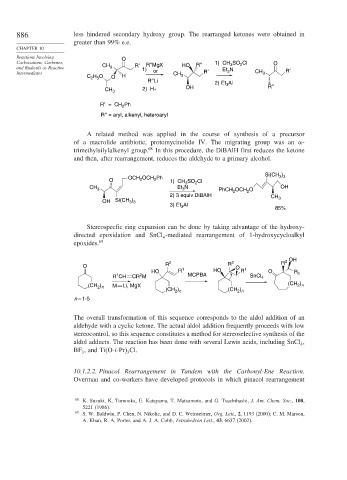Page 910 - Advanced Organic Chemistry Part B - Reactions & Synthesis
P. 910
886 less hindered secondary hydroxy group. The rearranged ketones were obtained in
greater than 99% e.e.
CHAPTER 10
Reactions Involving O
Carbocations, Carbenes, R′ R″MgX HO R″ 1) CH SO Cl O
2
3
and Radicals as Reactive CH 3 1) N R′
Intermediates or CH R′ Et 3 CH 3
C H O O H 3
2 5
R″Li 2) Et Al
3
CH 3 2) H+ OH R″
R′ = CH Ph
2
R″ = aryl, alkenyl, heteroaryl
A related method was applied in the course of synthesis of a precursor
of a macrolide antibiotic, protomycinolide IV. The migrating group was an -
trimethylsilylalkenyl group. 68 In this procedure, the DiBAlH first reduces the ketone
and then, after rearrangement, reduces the aldehyde to a primary alcohol.
Si(CH )
OCH OCH Ph 3 3
O 2 2 1) CH 3 SO Cl
2
CH 3 Et N PhCH OCH O OH
3
2) 3 equiv DiBAlH 2 2 CH
) 3
OH Si(CH 3 3
3) Et Al 85%
3
Stereospecfic ring expansion can be done by taking advantage of the hydroxy-
directed epoxidation and SnCl -mediated rearrangement of 1-hydroxycycloalkyl
4
epoxides. 69
2 OH
R
2
2
O R 1 R O 1
HO R HO R O R 1
2
1
R CH CR M MCPBA SnCl 4
(CH ) M Li, MgX (CH )
2 n
2 n
(CH ) (CH )
2 n
2 n
n = 1-5
The overall transformation of this sequence corresponds to the aldol addition of an
aldehyde with a cyclic ketone. The actual aldol addition frequently proceeds with low
stereocontrol, so this sequence constitutes a method for stereoselective synthesis of the
aldol adducts. The reaction has been done with several Lewis acids, including SnCl ,
4
BF , and Ti(O-i-Pr) Cl.
3
3
10.1.2.2. Pinacol Rearrangement in Tandem with the Carbonyl-Ene Reaction.
Overman and co-workers have developed protocols in which pinacol rearrangement
68 K. Suzuki, K. Tomooka, E. Katayama, T. Matsumoto, and G. Tsuchihashi, J. Am. Chem. Soc., 108,
5221 (1986).
69
S. W. Baldwin, P. Chen, N. Nikolic, and D. C. Weinseimer, Org. Lett., 2, 1193 (2000); C. M. Marson,
A. Khan, R. A. Porter, and A. J. A. Cobb, Tetrahedron Lett., 43, 6637 (2002).

